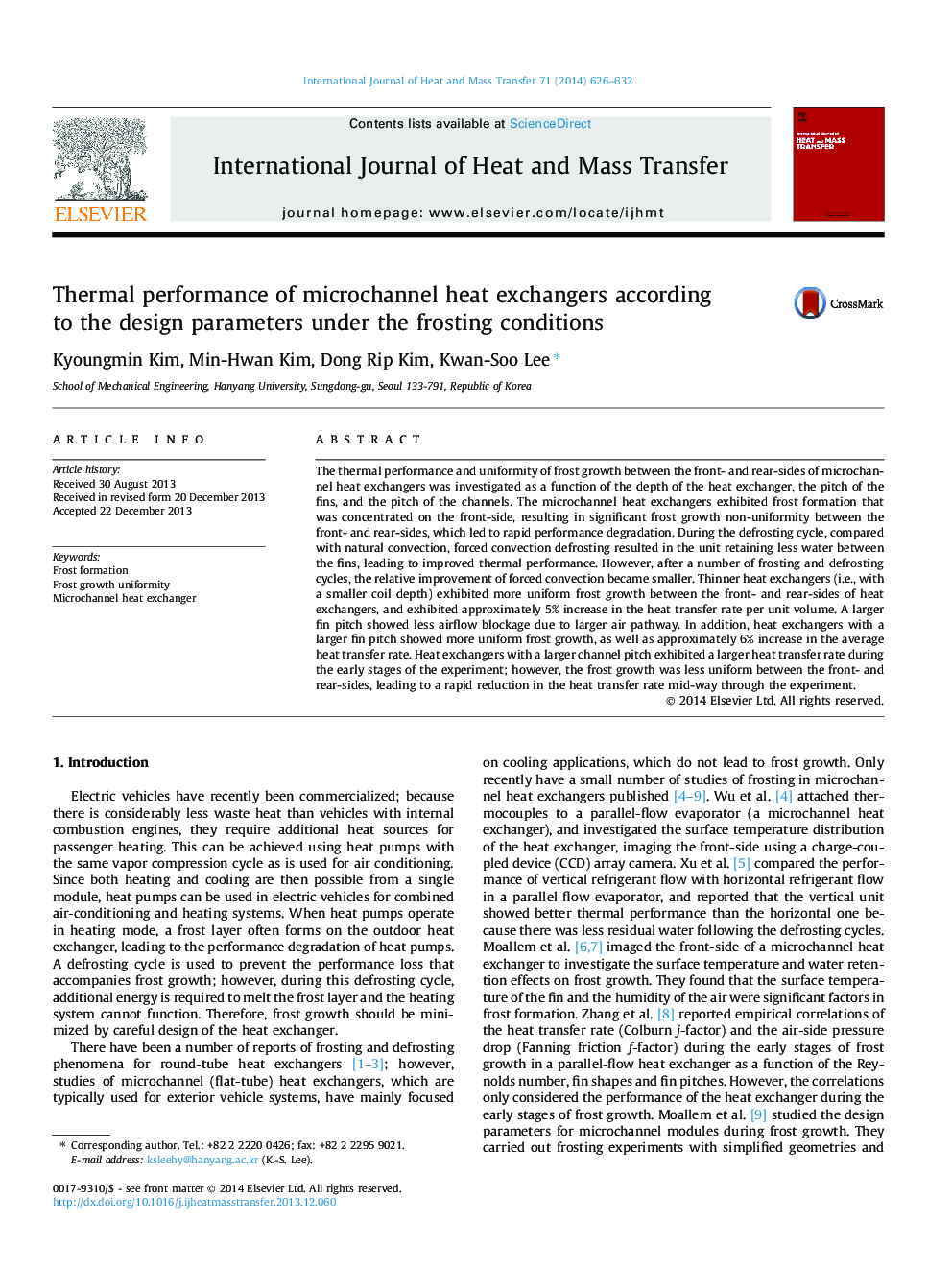| کد مقاله | کد نشریه | سال انتشار | مقاله انگلیسی | نسخه تمام متن |
|---|---|---|---|---|
| 7057744 | 1458071 | 2014 | 7 صفحه PDF | دانلود رایگان |
عنوان انگلیسی مقاله ISI
Thermal performance of microchannel heat exchangers according to the design parameters under the frosting conditions
ترجمه فارسی عنوان
عملکرد حرارتی مبدلهای حرارتی میکرو کانال با توجه به پارامترهای طراحی در شرایط یخ زدگی
دانلود مقاله + سفارش ترجمه
دانلود مقاله ISI انگلیسی
رایگان برای ایرانیان
ترجمه چکیده
عملکرد حرارتی و یکنواختی رشد یخبندان بین اجسام جلو و عقب مبدلهای حرارتی میکرو کانال به عنوان تابعی از عمق مبدل حرارتی، دامنه باله ها و زمین کانال ها مورد بررسی قرار گرفت. مبدلهای حرارتی میکرو کانال، شکل ظاهری یخبندان را نشان دادند که در قسمت جلو متمرکز شده بود و منجر به عدم انحطاط رشد یخبندان بین طرف مقابل و عقب گردید که منجر به تضعیف عملکرد سریع شد. در طی چرخه یخ زدایی، در مقایسه با سوزش طبیعی، انجماد اجباری اجباری منجر به کاهش میزان آب در بین باله ها شد، که منجر به بهبود عملکرد حرارتی شد. با این حال، پس از تعدادی از چرخه یخ زدایی و یخ زدگی، بهبود نسبی گرمای مجاز کوچکتر شد. مبدلهای حرارتی نازک (به عنوان مثال، با عمق کمتر کویل) رشد یخ زدگی یکنواخت بین طرف جلو و عقب مبدلهای حرارتی را نشان دادند و میزان انتقال حرارت را در واحد حجم حدود 5 درصد افزایش دادند. با توجه به مسیر هوایی بزرگتر، سطح بالایی بالش نشان دهنده انسداد جریان هوا بود. علاوه بر این، مبدل های حرارتی با یک ترمینال باله بیشتر نشان دهنده رشد یخ زدگی یکنواخت و همچنین افزایش متوسط سرعت انتقال حرارت حدود 6٪ است. مبدلهای حرارتی با کانال کانال بزرگتر در طول مراحل اولیه آزمایش میزان انتقال حرارت بالاتری را نشان دادند. با این حال، رشد یخبندان بین طرف جلو و عقب یکنواخت بود و منجر به کاهش سریع سرعت انتقال حرارت در میان آزمایش شد.
موضوعات مرتبط
مهندسی و علوم پایه
مهندسی شیمی
جریان سیال و فرایندهای انتقال
چکیده انگلیسی
The thermal performance and uniformity of frost growth between the front- and rear-sides of microchannel heat exchangers was investigated as a function of the depth of the heat exchanger, the pitch of the fins, and the pitch of the channels. The microchannel heat exchangers exhibited frost formation that was concentrated on the front-side, resulting in significant frost growth non-uniformity between the front- and rear-sides, which led to rapid performance degradation. During the defrosting cycle, compared with natural convection, forced convection defrosting resulted in the unit retaining less water between the fins, leading to improved thermal performance. However, after a number of frosting and defrosting cycles, the relative improvement of forced convection became smaller. Thinner heat exchangers (i.e., with a smaller coil depth) exhibited more uniform frost growth between the front- and rear-sides of heat exchangers, and exhibited approximately 5% increase in the heat transfer rate per unit volume. A larger fin pitch showed less airflow blockage due to larger air pathway. In addition, heat exchangers with a larger fin pitch showed more uniform frost growth, as well as approximately 6% increase in the average heat transfer rate. Heat exchangers with a larger channel pitch exhibited a larger heat transfer rate during the early stages of the experiment; however, the frost growth was less uniform between the front- and rear-sides, leading to a rapid reduction in the heat transfer rate mid-way through the experiment.
ناشر
Database: Elsevier - ScienceDirect (ساینس دایرکت)
Journal: International Journal of Heat and Mass Transfer - Volume 71, April 2014, Pages 626-632
Journal: International Journal of Heat and Mass Transfer - Volume 71, April 2014, Pages 626-632
نویسندگان
Kyoungmin Kim, Min-Hwan Kim, Dong Rip Kim, Kwan-Soo Lee,
